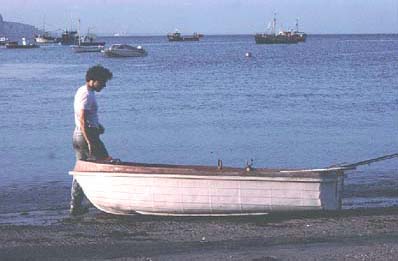 better we were permitted to spend an evening in the bay and, when we returned, to put the boat away by ourselves.
better we were permitted to spend an evening in the bay and, when we returned, to put the boat away by ourselves.
'On your marks! '
SMALL-EYED RAYS AND BLACK BREAM Part 1
Once again this chapter and the following one were originally combined in the book. However, it falls nicely into two parts - here is the first!
There is an irresistible urge to fish in waters beyond those fished by one's fellow anglers. Such feelings are deep-rooted, which is clear from the way that less experienced followers of the gentle art will always congregate at the outer end of a long pier. Touched by the same urge it was not long before we were exploring the waters of Swanage Bay from hired rowing dinghies. At first we would hire a boat for an hour or so in the afternoon, and explore by trolling spoons and spinners as we rowed out into the bay. Of necessity we were restricted to the holiday period, the only time when boats were for hire.
In the early summer, small pollack of up to 1.5-pounds were good sport on light line and a Toby spoon. Later in the year, mackerel and garfish were the usual product of similar excursions. As we came to know the boat-hirers better we were permitted to spend an evening in the bay and, when we returned, to put the boat away by ourselves.
better we were permitted to spend an evening in the bay and, when we returned, to put the boat away by ourselves.
This increase in fishing time led to attempts at bottom fishing, using worms or strips of mackerel and garfish as bait. The product of these efforts was little different to what we had experienced in using similar methods from the adjacent beaches or from the local pier.
Modest flounders, plaice and wrasse took the worms in the hours of daylight and at dusk pouting and poor cod took everything. One evening, as we returned particularly late from an abortive trip, some members of the local angling club were just unloading their motor boat and laying the catch on an old fish box. A couple of conger, 10- or 12-pounds each, three or four black bream of around a pound, a big edible crab and, wonder of wonders, a 9-pound ray. The latter was, in our eyes, a superb creature. In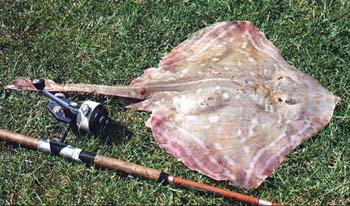 the light of our torch its pinky-grey skin gleamed dully and we could see an attractive pattern of white undulating stripes parallel to the margin of the disc. We talked about the fish all the way home and the following morning looked up the ray in Kennedy's Sea Anglers Fishes. There it was, large as life, the painted or small-eyed ray, a species of local distribution which had been caught on rod and line to a weight of just under 11-pounds. A 9-pounder was obviously a large fish.
the light of our torch its pinky-grey skin gleamed dully and we could see an attractive pattern of white undulating stripes parallel to the margin of the disc. We talked about the fish all the way home and the following morning looked up the ray in Kennedy's Sea Anglers Fishes. There it was, large as life, the painted or small-eyed ray, a species of local distribution which had been caught on rod and line to a weight of just under 11-pounds. A 9-pounder was obviously a large fish.
Already we had put in a fair number of hours fishing without so much as a sniff from a skate or ray. Either we were using the wrong baits or fishing in the wrong places. The tackles recommended by the pundits for such fish left little scope for imagination or variation. The use of a simple running leger, with the bait hard on or very close to the seabed was near enough to our usual style to make us confident, at least in this respect. Fresh mackerel was generally quoted as "a good-all-round bait" so we concluded that we must be fishing in the wrong places.
The seabed in the bay seemed to consist of extensive stretches of sand and was very uniform in depth. The first thing we needed was a decent map or chart. We bought the largest admiralty chart available and spent some time poring over it. It confirmed our observations - a more or less sandy level bed with very few of the features beloved of angling authors. There were no pinnacles, gulleys or holes within the range of our small rowing dinghy. In fact there was only one feature: running out obliquely from the shore was a rocky ledge which seemed to extend well out into the bay - certainly as far as we would want to venture. It would have to suffice. Then we came to the problem - how did one locate such bed features in several square miles of water? (There was no hand held GPS at the time). There were plenty of shore marks but they were not shown on the chart and we had no refinements such as echo sounders or Decca navigators.
We watched, with more than a passing interest, the marks used by local anglers and crabbers but it was soon obvious that their positioning was usually approximate within pretty wide limits. There were, nonetheless, a couple of areas that seemed to be favoured and both were in the vicinity of the presumed ledge. We set out to find and hopefully to map the ledge, using a hand line tied to a 5-pound lead. Choosing a calm sunny afternoon we traversed back and forth. There was nothing subtle about our methods and we soon realised that it was not possible to draw any sort of map but we did manage to obtain cross bearings on a couple of features, standing five to ten feet from the surrounding seabed in thirty foot of water. We presumed that these were sections of the ledge and we set out to fish these places regularly under a range of tidal and weather conditions.
The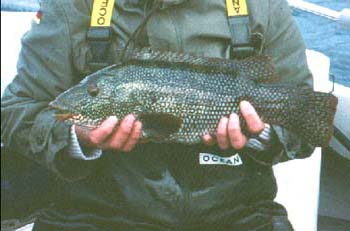 problem lay in the expense of the hired boat. We were forced to fish only about once in every couple of weeks and it was obviously going to take some little time to build up any sort of picture at that rate. On the first couple of trips, which we made to the 'ledge mark', the efforts paid off. The first time out we boated two conger, one of 8-pounds and one of 12-pounds. Both took mackerel fillets presented on 30-pound B.S. wire traces and 4/0 hooks, the same sort of tackle which we were accustomed to using when conger fishing from the beach.
problem lay in the expense of the hired boat. We were forced to fish only about once in every couple of weeks and it was obviously going to take some little time to build up any sort of picture at that rate. On the first couple of trips, which we made to the 'ledge mark', the efforts paid off. The first time out we boated two conger, one of 8-pounds and one of 12-pounds. Both took mackerel fillets presented on 30-pound B.S. wire traces and 4/0 hooks, the same sort of tackle which we were accustomed to using when conger fishing from the beach.
Harry and I took a second trip on a perfect evening following a hot July day. As we launched the clinker-built, varnished dinghy with a large number 12 painted on the bow, the day's sea breeze was already dying away. The usual Tobys were trolled on the way to the mark but we had no bites; it was high tide now and there was very little water movement.
The large stone that served as an anchor was lowered to the seabed when we were still a few oar strokes from the mark. As the boat came to rest we checked that the left-hand chimney of the house on the cliff was in line with the folly on the hill and that the big elm tree was just behind the right-hand edge of the large white house. I unclipped the Toby from my line and replaced it with a 1-ounce pirk, which I lowered to the seabed and proceeded to jig up and down.
Harry rigged a simple paternoster bearing a size-six hook baited with ragworm and lowered it gently until he felt the half-ounce bomb tap on the bottom. For half-an-hour neither method produced any form of action. Eventually Harry's rod tip twitched gently and he became alert; another twitch was followed by a sharp strike. 'Missed' he exclaimed and reeled in to examine the bait. Where the worm had been threaded, hung a plump black goby of about 5-inches in length. 'Lets give it a try as bait, I'll cut it in two' I said. 'Don't bother; it's not worth it. Put it on whole and I'll try to catch another.' was the response. I killed the goby and lip hooked it firmly on the 4/0 hook. A 1-ounce lead was fixed to the sliding link and the tackle slowly lowered to the seabed. Ten minute later Harry reeled in another goby. His second rod, a ridiculous 5-foot glass wand with the Ambassadeur 5000 on the butt was set up in a similar manner to my own.
The sun was by now going down over the hills to the west of the bay and the street lamps along the sea front were casting rippling yellow patterns across the surface of the darkening sea. Harry began to catch a series of small pouting on worms, so I took off the pirk and rigged up a second wire trace baited with half a pouting (lip hooked head and shoulders). Having caught half-a-dozen 'baits' Harry also changed to a big bait, using the tail half of the pouting.
We settled down for a wait and a chat. The tide was ebbing slowly now and the anchor rope had straightened out, so two of the rods were reeled in and fitted with 2-ounce leads in order to fish more or less straight down under the boat. The other two rods, with lighter weights, were several yards astern. We each drank a cup of coffee and talked of fishing.
A slow dragging pull took a few inches of line from my goby-baited rod. I picked it up and for a moment it felt as though it was snagged. Then it slowly came free but the rod was bent with a weight much greater than a one-ounce lead. 'Crab,' I muttered and began the slow wind to the surface. Harry picked up the landing net and the torch. As he shone the torch in the direction indicated by the line and into the water: six foot down a brownish blur was visible. Gradually it took the form of a large, red-eyed, purple-clawed velvet swimming crab. Harry lifted it into the boat and shook it out of the net. Its rear paddles clattered on the bottom of the boat and it scuttled under the stern seat where it braced its legs against the boards and held up its claws in the characteristic threat. I picked up the crab and dropped it over the side. My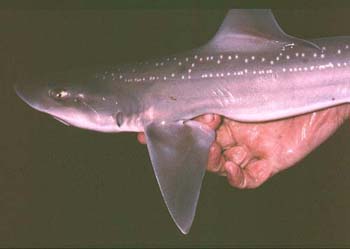 goby had been mashed to pulp so I replaced it with a fillet of pouting and cast again.
goby had been mashed to pulp so I replaced it with a fillet of pouting and cast again.
We had been so absorbed in dealing with the crab that neither of us had noticed Harry's multiplier clicking gently. Now, in the silence, it sounded like the ticking of a grandmother clock. As Harry reached out and picked it up the clicking accelerated, and two feet of line ran quickly from the spool. The sound of the ratchet ceased and I said, 'Has it dropped the bait?' 'I don't think so' replied Harry and, as he spoke, the fish began to run again, steadily this time.
A turn of the handle set the multiplier in gear and as the rod curved smoothly to the pull of the running fish, he struck hard. It was well hooked and began to dive away, swimming with the flow and steadily taking line against the firmly set check. As the run slowed down Harry raised the rod and retrieved a little line by pumping. Each lift of the rod now regained a few feet of line and the fish, still resisting heavily, planed from side to side.
I switched on the big rubber torch and took the piece of protective Bunsen tubing off the point of the gaff. In the light of the torch the clear shape of the fish was already visible a couple of yards behind the dinghy. 'It's a ray,' we shouted simultaneously. Instantly the fish took on a new importance; it was our first ray. Harry steered the fish carefully round the other line and drew it towards the boat. I plunged the gaff through it in the angle between the tail and the body and lifted it into the boat.
Had the boat been larger we would have jumped for joy! The hook was in the corner of the ray's mouth and was easily removed. On Harry's spring balance the fish registered 10.5-pounds, a female thornback and quite distinct from the small-eyed ray which we had previously seen.
On subsequent trips we came to realise that thornbacks were one of the less common species on the sandy bed of Swanage Bay. We were now aware of one mark on which rays could be caught and also that at least two species were present in the area. In fact, as we later found, the fish could just as easily been any one of half-a-dozen species; spotted rays, blonde rays, small-eyed rays, thornbacks, undulate rays and even small (very small) common skate were present in the area at times.
The considerable variety of similar species fascinated us, and for several years ray fishing became one of our main interests. In general, rays are regarded, correctly, as scent feeders, finding their prey primarily by way of the chemicals that it exudes into the water. All of them however have good-sized eyes and many species have a well-developed electrical sense. The thornback, for example, has been shown to be capable of detecting the electrical activity due to the breathing muscles of a resting plaice buried under the sand.
Quite a bit of information is available regarding the feeding and the preferred foods of the different species. The food of rays changes dramatically with size and for convenience we have shown a distinction between small fish of less than 18-inches in length and the, more desirable, larger specimens.
The small spotted ray shows only a slight shift in emphasis of its diet. ragworms and hoppers (amphipods) are important food items in fish of all sizes, but with rather more crab and sand eel in the larger specimens. The thornback shows a much greater change, with smaller fish feeding mainly on shrimps and porcelain crabs, while the larger ones eat a high proportion of swimming crabs and various types of fish. The blonde ray is chiefly a fish eater and 63 per cent of all fish up to 4-feet in length contained mostly sand eels. The general pattern is one of a change from ragworms, shrimps, and hoppers in small rays to increasing proportions of fish and larger crabs in the older, larger fish.
general pattern is one of a change from ragworms, shrimps, and hoppers in small rays to increasing proportions of fish and larger crabs in the older, larger fish.
The original ledge mark on which we had taken our first thornback came later to be referred to as the 'skate mark' because it was a prolific source of several species of ray. In the year following our first modest success we were able to fish regularly on two or three evenings each week because Stan (one of our mates) allowed us to use his 11-foot fibreglass and marine-ply dinghy.
In the following May, one evening after tea, Harry and I were once again to be seen piling Barbour jackets, rods, gaffs, tackle bags, oars (three), ropes, cushions (essential) and concrete-filled one gallon plastic containers which we used as anchors, out of the car and onto the slipway. Harry went to park the car and then the two of us, one lifting the bow and the other the stern of the boat, staggered down to the waters edge. As we stumbled down the slipway, we muttered phrases such as, 'Either this damn boat's getting heavier or I'm getting weaker.' Then, 'Isn't it time we got a launching trolley?' The rowlocks were fitted and tied in place, the anchor rope tied on and coiled in the bow, the tackle was carefully stowed and we set out on the one-mile row to the mark. Harry had already set up his spinning rod armed with a 1-ounce lead and a small Mepps three feet behind it. This he trolled on the way out, taking a mackerel and two small pollack before we anchored up.
Allowing for the wind and tide we shipped the oars and lowered the anchor 'stones' to the seabed. One stone was sufficient for a neap tide but this particular night two were tied on about six feet apart to cope with the run of the spring tide and the stiff breeze. Once the anchor rope had drawn tight we checked the position of the marks. Because of the wind we had miscalculated slightly so we hauled up the anchors and moved until we were spot on. This may seem ridiculous, but to eliminate the effect of position from the complicated considerations of time, tide, weather and bait, it was essential.
Even though we had caught a mackerel on the way out the first job was to fish for more bait. We had already established, to our own satisfaction, that neither frozen squid, frozen fish nor fresh mackerel held any advantage over freshly-caught pouting, poor cod or gobies when it came to catching rays or conger. With hindsight, our eventual average of about one good fish per trip, almost all taken on pouting, seems to bear this out.
Bait catching involved the use of light paternosters or legers baited with worm, squid or mackerel strip. During the hours of daylight small wrasse took the worms but as soon as the sun fell below the horizon the pouting began to feed. During the wait for small fish to bite, two additional rods were baited, one with a small squid and the other with a fillet of mackerel; both were lowered to the seabed and the rods secured, well inboard, with the checks set lightly. In catching baitfish we had found that a smear of pilchard oil on the worms helped to attract pouting, as did a certain amount of bait movement.
The tidal current was running very hard and, even with 2-ounces of lead, the lines angled away from the stern. Lines of about 18-pounds B.S. were being used for the larger fish because, although rocks were fairly close at hand, even large conger rarely went to ground. Provided wire traces were used few fish had been lost on snags, nor indeed by any form of breakage. In the fast-flowing water, every few minutes one or other of the baits would be attacked by crabs, some of which were of good size. Frequently this resulted in a badly torn bait and several times a crab was lifted a few feet from the seabed before it would let go. Already Harry had boated two, which had been retained for eating. A large spider crab had also been brought to the net; the span of its legs was almost 18-inches and it had tucked them up into the form of a tight basket as it was picked up and returned. After an hour or so of crab activity bait was beginning to run low and there was some relief when a sharp bite on Harry's rod resulted in a pouting of about 1.5-pounds, plenty to keep us going for the evening.
The ratchet of my light rod began to click as the spool slowly rotated, the tide was easing off and the boat, swinging on its anchor rope, was drawing line off the reel. On picking up the rod I found the tackle solidly wedged. Taking the line in my gloved hand I pulled steadily and the tension eased smoothly as it came free, a quite different feeling from the 'ping' of a parting knot. On retrieving the tackle I found the bait gone and the point of the hook slightly turned. I resharpened it, baited up with a large pouting fillet and again lowered the tackle to the seabed.
As I looked up, Harry was holding the lighter of his rods at the ready. 'What is it?' I asked. 'Not a conger or a skate' said Harry. 'Just one fast pull - there it is again!' and, as he spoke, he lifted the rod tip sharply in an answering strike. The fish bored away. Again and again it dived steeply, pulling the little rod into a deep curve and twice even plunging the tip beneath the waves. Clearly it was not a very big fish, for between the dives Harry was easily regaining line. As the fish neared the boat we saw the rounded silver outline of a black bream. Once in the net we noted the fish was a female, in characteristic brownish and silver livery, its belly swollen with eggs. The mouth of the bream seemed scarcely large enough to have absorbed the whole squid and 4/0 hook but it was hooked well down. Had we known it at the time, the catching of this fine 2-pound fish on whole squid was to prove significant in later years of dinghy fishing.
For half-an-hour things went quiet, with not even a crab or pouting to relieve the stillness. Even the reliable old cup of undrinkable coffee had failed to produce any action. While we endured our coffee we talked and laughed about Trevor's experience the previous weekend. Having lost a snagged folding anchor on an earlier trip he decided to attach a second, buoyed, line to his expensive new anchor so that, should the event recur, he would be able to 'pull up the hook' from a different direction. He and his wife were contentedly anchored up in his 10-foot Romany plastic dinghy, bottom fishing for rays, about two hundred yards out from Swanage pier.
The action had been very quiet and there were no signs of any fish. 'Perhaps they will come later on when the tide turns, said Trevor. As he spoke, the line on his Alvey reel started running off. The clicks from the ratchet sounded like a machine gun. 'It must be a tope,' he shouted. 'I've got a bite as well,' said his wife. 'Perhaps it's the same fish'. As Trevor picked up his rod, he suddenly realised that the line was running from his reel because the boat was moving. Not only was it moving but it was travelling at a steady four or five knots, far faster than it had ever gone before. He looked over the prow of the boat to see his anchor rope stretched tautly in the direction of a large motorboat, taking a full load of holidaymakers on a tour of Swanage Bay.
Trevor shouted to the boatman who was looking the other way and obviously could not hear. He frantically waved his hands in the direction of the motorboat and all the holidaymakers in the pleasure craft cheerfully waved back. One could almost hear them saying, 'What a nice friendly fellow in that little boat that's following us.' After a good four or five minute the boatman realised what had happened, slowed down and released the buoyed line attached to the anchor. Immediately Trevor and his wife set off for the shore, vowing to substitute a tripped anchor on the next outing.
Still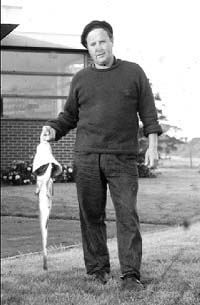 no action. Harry and I reeled in and changed to fresh baits - there were pouting fillets on all four rods now. It is good practise to change baits at intervals of about twenty to thirty minutes in any event, so as to maintain a strong scent trail. Five minutes after the baits had settled, the reels on both the heavier rods began to give line simultaneously. 'Could be the boat swinging again.' murmured Harry, but, as one man, we picked up our rods and gently fingered the lines in an attempt to determine what was going on below.
no action. Harry and I reeled in and changed to fresh baits - there were pouting fillets on all four rods now. It is good practise to change baits at intervals of about twenty to thirty minutes in any event, so as to maintain a strong scent trail. Five minutes after the baits had settled, the reels on both the heavier rods began to give line simultaneously. 'Could be the boat swinging again.' murmured Harry, but, as one man, we picked up our rods and gently fingered the lines in an attempt to determine what was going on below.
I told Harry that I could feel the taut nylon twitch at intervals of two to three seconds. 'This is a fish as well!' came his reply and, as if in confirmation, the line began to run steadily off the spool of his lightly-thumbed multiplier. My fish had also moved off and the coils of line were slipping over the edge of the spool and out between my index finger and thumb, I lowered the rod slightly to give an extra foot or of line as I brought over the bale arm on the reel. The line tightened and the rod began to bend as the weight of the fish made itself felt. I struck firmly and felt the resistance of a decent fish. Looking up, I could see that Harry was also into something sizeable.
My fish began to swim up tide towards the bow of the boat where the anchor rope was visible. I leaned heavily on the rod and managed to turn the fish, only to find that Harry's line had swung across the stern and was now close to mine. My fish was less of a handful than Harry's and I was now making good progress. 'Wait until I get mine in the boat and I'll give you a hand.' I said. The fish was already on the surface, a small-eyed ray of about 8-pounds with the trace looped around its tail. I lifted it by the tail and swung it into the boat. Laying down the rod I picked up the gaff and the torch. A long white shape gleamed faintly far below and Harry's rod bowed and the line sang as the fish plunged away again.' It looks like a nice conger.' I said. 'Take it easy.' But no such advice was needed and the fish was slowly but surely brought up to the surface where it spun gracefully in the current five yards astern.
Swinging the rod to starboard, Harry recovered line until the conger was alongside. The gaff was in and I lifted the squirming eel inboard. Harry put down the rod, picked up the blue nitro-chalk sack into which I dropped the fish off the gaff, cut the line above the trace and tied the mouth of the sack with a piece of orange courlene twine brought along for that purpose. Before Harry could tackle up again his other rod, which was still fishing, began to nod as another fish ran swiftly off with the bait. This time we were better organised and after a battle of about five minutes a second small-eyed ray of 11.5-pound was in the fish box.
As we rowed back across the bay, guided by the red light on the pier end, the green phosphorescence shone in the wake and on the tips of the oars.
We were well satisfied!